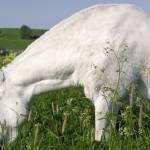Understanding Fructans in Equine Diets

Fructans, one class of fermentable polysaccharide stored in cool season grasses, can be digested in the horse’s stomach and hindgut by bacterial fermentation but not by enzymatic hydrolysis in the small intestine. Unlike the relatively stable level of starch in a particular cereal grain, grass fructan levels are immensely variable, making up from 5 to 50% of the grass dry matter (DM). Horses also vary somewhat in their sensitivity to the fructans they consume. These factors help to explain why one horse can freely graze fresh spring pastures with no problem, while another horse may develop warm, painful hooves after only a few hours or days of grazing.
Undigested fructans that enter the hindgut trigger a reduction in cecal pH, upsetting the balance of microorganisms and leading to the production of toxins that cause inflammation. This cascade of events may lead to laminitis. To minimize the risk, horse owners can restrict free grazing during times when fructan levels are likely to be elevated, such as during early spring and fall, beginning with several short grazing sessions each day and gradually increasing length and number. Using a grazing muzzle to slow grass consumption, keeping the horse in a drylot for part of the day, and continuing to offer hay in addition to pasture are additional ways to provide more dry matter and limit the intake of fructans
Fresh grass is very appealing, and horses can chomp through an incredible amount of forage in a relatively short time. Owners should not assume that stalling for twelve hours and turning out for the remaining hours will cut grass consumption in half, as the horse will prefer grazing over napping, exercising, or socializing with other horses.








